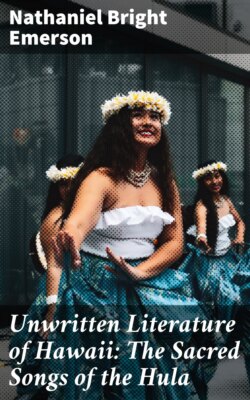Читать книгу Unwritten Literature of Hawaii: The Sacred Songs of the Hula - Nathaniel Bright Emerson - Страница 40
На сайте Литреса книга снята с продажи.
[Translation]
ОглавлениеThy blessing, O Laka, on me the stranger, and on the residents, teacher and pupils. O Laka, give grace to the feet of Pohaku; and to her bracelets and anklets; comeliness to the figure and skirt of Luukia. To (each one) give gesture and voice. O Laka, make beautiful the lei; inspire the dancers when they stand before the assembly.
At the close of this service of song and prayer the visitor will turn from the kuahu and exchange salutations and greetings with his friends in the halau.
The song-prayer "Now, Kane, approach, illumine the altar" (p. 45) calls for remark. It brings up again the question, previously discussed, whether there were not two distinct cults of worshipers, the one devoted to Laka, the other to Kapo. The following facts will throw light on the question. On either side of the approach to the altar stood, sentinel-like, a tall stem of hala-pepe, a graceful, slender column, its head of green sword-leaves and scarlet drupes making a beautiful picture. (See p. 24.) These are said to have been the special emblems of the goddess Kapo.
The following account of a conversation the author had with an old woman, whose youthful days were spent as a hula dancer, will also help to disentangle the subject and explain the relation of Kapo to the hula:
"Will you not recite again the prayer you just now uttered, and slowly, that it may be written down?" the author asked of her. "Many prayers for the kuahu have been collected, but this one differs from them all."
"We Hawaiians," she answered, "have been taught that these matters are sacred (kapu) and must not be bandied about from mouth to mouth."
"Aye, but the time of the tabus has passed. Then, too, in a sense having been initiated into hula matters, there can be no impropriety in my dealing with them in a kindly spirit."
"No harm, of course, will come to you, a haole (foreigner). The question is how it will affect us."
"Tell me, were there two different classes of worshipers, one class devoted to the worship of Laka and another class devoted to the worship of Kapo?"
"No," she answered, "Kapo and Laka were one in spirit, though their names were two."
"Haumea was the mother of Kapo. Who was her father?"
"Yes, Haumea was the mother, and Kua-ha-ilo 86 was the father:"
"How about Laka?"
Footnote 86:(return) Kua-ha-ilo. A god of the kahuna anaana; meaning literally to breed maggots in the back.
"Laka was the daughter of Kapo. Yet as a patron, of the hula Laka stands first; she was worshiped at an earlier date than Kapo; but they are really one."
Further questioning brought out the explanation that Laka was not begotten in ordinary generation; she was a sort of emanation from Kapo. It was as if the goddess should sneeze and a deity should issue with the breath from her nostrils; or should wink, and thereby beget spiritual offspring from the eye, or as if a spirit should issue forth at some movement of the ear or mouth.
When the old woman's; scruples had been laid to rest, she repeated slowly for the author's benefit the pule given on pages 45 and 46, "Now, Kane, approach," … of which the first eight lines and much of the last part, to him, were new.
